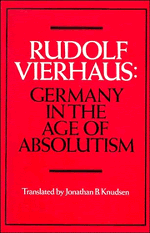5 - Wars, Crises, and Conflicts
Published online by Cambridge University Press: 05 June 2012
Summary
PRELIMINARY REMARKS: GERMANY AND EUROPE
The Westphalian Peace in 1648 was much more a European event than earlier peace settlements had been. Delegates from almost every European power took part in negotiations that became the first of the peace conferences typical of future European diplomacy. Although the signatories assured that the peace was to be “Christian, universal, and eternal,” this proved not to be the case. There were indeed no further internal German wars until 1740, but German dynasties were continually involved in new wars. This was especially true for the Habsburgs with interests and lands spread throughout Europe and overseas. Still Germany was no longer the main staging area for war. More than ever before and for more than a century to come, the important political decisions were not made in central Europe. At no other time were the policies of the German states so determined by those of the great European powers. This fact had direct, though contradictory, consequences for German domestic policies. In one case a ruler's efforts to win prestige or additional territory might cause him to link himself to the great powers; the alliance might thereby unleash intense struggles with the estates, causing foreign policy in the end to trigger an expansion of central authority. On the other hand, the conflicts might remain unresolved or the prince might be defeated, thus generating turmoil and even disaster.
- Type
- Chapter
- Information
- Germany in the Age of Absolutism , pp. 116 - 143Publisher: Cambridge University PressPrint publication year: 1989



